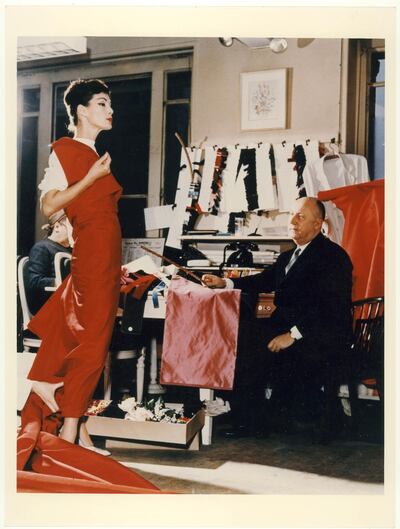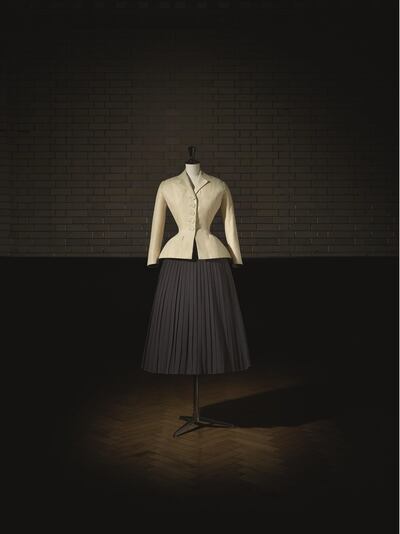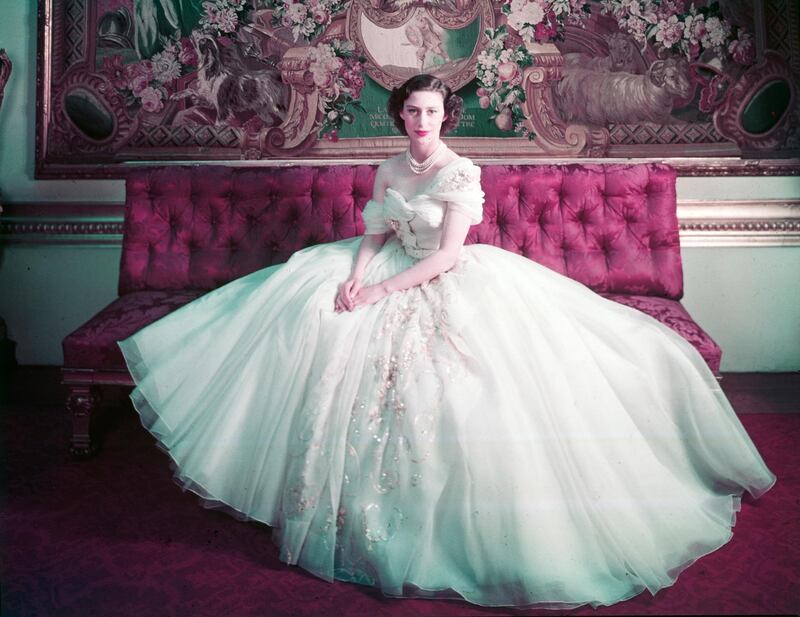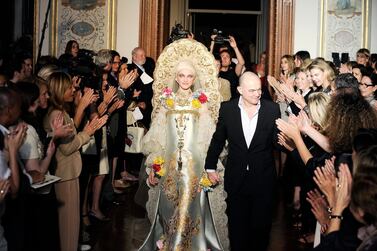Until recently, it is unlikely that many of the international visitors to London's Victoria and Albert Museum would have taken much interest in a ballgown worn by Princess Margaret. However, thanks to the success of Netflix series The Crown, the matinee poetique dress worn by the princess on her 21st birthday is given pride of place at an exhibition that celebrates the success of one of the world's greatest fashion houses.
Christian Dior: Designer of Dreams is the largest exhibition of works created by the house of Dior to be staged in the United Kingdom. It is an extension of last year's exhibition in Paris, titled Christian Dior: Couturier du Reve, but about 60 per cent of the 500-plus objects in the current retrospective were not on display at the Musee des Arts Decoratifs.
In addition to 200 couture gowns, limited-edition perfume vials and yellowing sketches by Dior himself, Designer of Dreams also includes a section dedicated to the Frenchman’s uncommon fascination for all things British, including the royal family. “There is no other country in the world, besides my own, whose way of life I like so much,” the designer once wrote. “I love English traditions, English politeness, English architecture. I even love English cooking.”
Christian Dior, who died in 1957, first visited London when he was in his early 20s. He soon developed a taste for English cars, bought his suits from Savile Row and launched his business in London, in 1952, as CD Models (later renamed Christian Dior London), as a high-end ready-to-wear boutique, with ready-made versions of the Parisian maison’s haute couture designs.

The V&A already possessed a significant number of Dior objects, including a suit worn by German actress Marlene Dietrich in 1950, which was part of a recent exhibition on ocean liners. However, the museum carried out hours of research to find never-before-seen items for the Designer of Dreams exhibit. Through contacting almost every museum and archive in the UK, the team discovered Dior's fascination with British textiles. One particular dress, which the V&A borrowed from Leicester City Council, features a rose pompom design with silk supplied by London textile manufacturer Ascher. The extremely fine fabric was woven in the northern English town of Macclesfield.
“It has been really interesting to uncover the stories and the connections,” says curator Connie Karol Burks. “The most notable is Princess Margaret. We feel very lucky to have her favourite dress, which was designed especially for her 21st birthday, in which she was photographed by Cecil Beaton.” The fairy-tale white tulle gown, which was recently restored by the Museum of London, is hand-sewn and features straw and mother-of-pearl embroidery detailing.
In fact, Princess Margaret, the younger sister of Queen Elizabeth II, was a Dior customer for many years after their first meeting in 1949, and the designer was enamoured with his royal client, describing her as “so very charming”. In 1950, he put on a private fashion show for the princess and the Queen, as well as princesses Marina the Duchess of Kent, and Olga of Greece at the French embassy in London, as well as staging multiple fashion shows at stately British manors, including Blenheim Palace in 1954.
Dior also collaborated with British milliner Steven Jones for more than 20 years. Jones's hats are a firm favourite with royalty and celebrities alike. At the wedding of Prince Harry and Meghan Markle, numerous guests including Amal Clooney and Lady Kitty Spencer sported his creations. Jones, who designed all the masks, hats and fascinators worn by the mannequins in the Dior exhibition, says it is always an honour when a designer is asked to make a creation for a member of the royal family.
“Often when a member of the royal family is wearing a hat, it’s for an official occasion. Yes, they want to look fashionable, but more importantly they need to look well dressed and a representation of royalty,” he says.
The House of Dior, too, maintains an enduring relationship with royalty to this day. Another notable garment shown in the exhibition is a version of the midnight blue satin slip dress worn by Princess Diana to the Met Gala in 1996. The dress was a part of former head designer John Galliano's first haute couture collection for the fashion house. "It sent shock waves because it was a very sophisticated, quite sexy dress. It was a headline-grabbing garment," says Burks.
The dress was not the first time Dior grabbed the attention of the international press. In 1947, the designer's now memorable Bar suit caused a huge uproar. Part of Dior's New Look collection, the skirt suit featured a pinched-in waist and a long corolla skirt, marking a departure from the rising hemlines and boxy shapes of the 1940s.

Women in Chicago protested against the outfit because of its impractical feminine style in a post-war age when women had joined the workforce in large numbers. The protesters stood with placards which read: “Mr Dior, we abhor dresses to the floor.” Later, there were reports of women in Paris wearing the Bar suit having it ripped off them.
Despite the infamy, the New Look collection was a huge hit among women who loved the romantic, nostalgic style. The Bar suit – and subsequent Dior designs – came to define the silhouette of the 1950s, and is the first thing visitors entering the exhibition will see.
To this day, head designers at Dior have looked back on the New Look era for inspiration. Even Maria Grazia Chiuri, Dior’s first female creative director who has been credited with giving the fashion house a feminist reinvention, revisited the Bar jacket in her autumn / winter 2018 couture collection.
“What I found most surprising when looking at objects in the archive, is trying to tell which era they came from,” says Burks. “Some of Christian Dior’s designs were modern, avant-garde and quite shocking in his cut and construction. There’s a timelessness, a classicism and a tailoring that hasn’t gone out of fashion, and I don’t believe ever will.”
Christian Dior: Designer of Dreams is at the Victoria and Albert Museum, London, until July 14







